

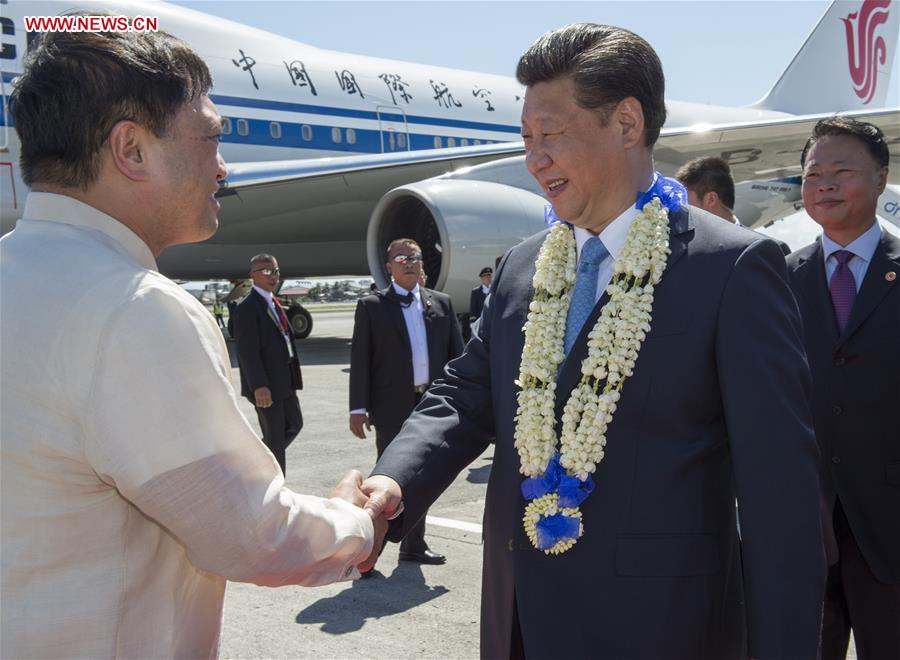 |
| Chinese President Xi Jinping (R Front) arrives in Manila, Philippines, Nov. 17, 2015 for the 23rd APEC economic leaders' meeting. (Xinhua/Li Xueren) |
MANILA, Nov. 17 -- Chinese President Xi Jinping arrived here Tuesday to attend the 23rd Asia-Pacific Economic Cooperation (APEC) Economic Leaders' Meeting at a time when the region expects more "China opportunities" for economic integration.
Xi was welcomed by senior Philippine government officials. Leung Chun-ying, chief executive of China's Hong Kong Special Administrative Region, and Chinese Ambassador to the Philippines Zhao Jianhua were also present at the airport to greet the president.
During his stay in Manila, Xi will deliver an important speech at the APEC Economic Leaders' Meeting, attend the APEC CEO summit and give a keynote speech, and attend the dialogue between the APEC leaders and representatives of the APEC Business Advisory Council.
He will expound China's policy on cooperation in the Asia-Pacific region and the implementation of the consensus reached at last year's APEC meeting in Beijing.
The president is also expected to introduce the progress made in implementing the China-proposed Belt and Road Initiative and the opportunities the proposal brings to the region and the world.
Xi's presence at the APEC meeting shows China's support to the host country and that China attaches great importance to APEC process, Chinese Foreign Minister Wang Yi said during a working visit to the Philippines a week ago.
Themed "Building Inclusive Economies, Building a Better World," this year's APEC meeting will focus on such specific subjects as regional economic integration, small and medium-sized enterprises, human capital development and sustainable growth.
As the top-level and most representative cooperation mechanism that covers a wide range of areas in the Asia-Pacific, the 21-member APEC has played an important role in advancing trade liberalization and facilitation, promoting economic integration and boosting connectivity.
The Asia-Pacific region, which is vital to global peace and development, accounts for 40 percent of world population, 48 percent of world trade, and 57 percent of global output.
Xi arrived here after attending a summit of the Group of 20 (G20) in the Turkish coastal city of Antalya, where he said the Chinese economy is predicted to grow about 7 percent this year, which will continue to contribute as high as about one third to the global growth.
PROSPECT OF FTAAP
Last year, APEC members endorsed a roadmap for promoting the Free Trade Area of the Asia-Pacific (FTAAP) process at the APEC meeting in Beijing.
Since then, the FTAAP has become a new objective for APEC regional integration, said Chinese Vice Commerce Minister Wang Shouwen, adding that China is willing to work together with relevant parties to complete a collective strategic study of the FTAAP by the end of 2016.
According to him, a statement is expected to be issued at the Manila summit in support of the multilateral trade system in the Asia-Pacific.
"The FTAAP, if implemented, will be the largest free trade area in the region, consolidating a myriad of already existing FTAs between China and major economies in the region," said Richard Javad Heydarian, an assistant professor of political science at De La Salle University in the Philippines.
The FTAAP is seen as both comprehensive and flexible, and many countries are carefully looking at its feasibility studies, he said.
Tang Guoqiang, chairman of the China National Committee for Pacific Economic Cooperation Council, said the FTAAP can become an "aggregation" of existing free trade arrangements.
Negotiations on the Regional Comprehensive Economic Partnership (RCEP), a free trade pact involving the 10-member ASEAN and six other countries, including China, have entered a crucial phase.
In addition, the full text of the Trans-Pacific Partnership (TPP) was released on Nov. 5, one month after 12 Pacific Rim countries concluded talks on the trade deal.
"China, as the world's second largest economy and the engine of the Asia-Pacific regional economy, is of paramount importance to regional economic integration. At the same time, China is open to every multilateral trade mechanism in the region," said Tang.
FIVE-YEAR PLAN BRINGS "CHINA OPPORTUNITIES"
In early November, a key meeting of the Communist Party of China (CPC) issued the full text of proposals for China's development from 2016 to 2020, setting a target of "maintaining medium-high growth" and saying that an annual growth of 6.5 percent would be required for China to "build a moderately prosperous society" by 2020.
The meeting also emphasized that China should "highlight innovation, coordination, the environment, opening up and sharing" to fulfill its economic goals.
"The growth rate of 6.5 percent is still quite high compared with other economies in the region," said Tang.
He predicted that China will undertake deeper reform and wider opening-up in its 13th Five-Year Plan period, the home stretch for China to realize a moderately prosperous society.
For instance, green development, which is a key word for the five-year plan, will bring opportunities for countries in the Asia-Pacific region, as China will import a variety of products relating to new energy, such as electric vehicles, said Tang.
He added that in the coming five years, China will further be open to the world, particularly the Asia-Pacific region, through projects like the Belt and Road Initiative.
In the opinion of Benito Lim, a professor of political science at Ateneo de Manila University, China is widely recognized as the leading economy in the Asia-Pacific region.
"If the Chinese economy grows at relatively high speed, it will benefit the whole region through trade and commerce," said Lim, who is also a former Philippine diplomat to China.
Through the Belt and Road Initiative and the Asian Infrastructure Investment Bank (AIIB), he noted, China not only provides investment for infrastructure construction, but also "literally opens the market for the rest of the countries in Eurasia."
"It is a very unusual pursuit and new strategy that I've never seen before. Through the initiative, China encourages countries to form economic partnerships and really promote connectivity and integration," he said.
Day|Week

 118-meter-high Never-used Building in NW. China Demolished
118-meter-high Never-used Building in NW. China Demolished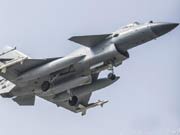 J-10B fighters with homegrown engine in test flight
J-10B fighters with homegrown engine in test flight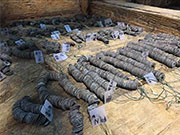 10 tons of copper coins unearthed in 2,000 years old ancient tomb
10 tons of copper coins unearthed in 2,000 years old ancient tomb Beautiful graduate from police college becomes Internet hit
Beautiful graduate from police college becomes Internet hit Photos of U.S. Navy intruding in South China Sea released
Photos of U.S. Navy intruding in South China Sea released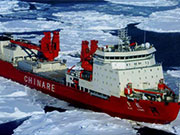 What is inside China's icebreaker ‘Xuelong’?
What is inside China's icebreaker ‘Xuelong’? Chinese, U.S. navies hold first-ever joint exercise in the Atlantic
Chinese, U.S. navies hold first-ever joint exercise in the Atlantic In pics: skies of glory
In pics: skies of glory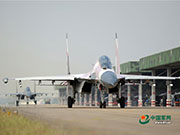 J-10, J-11, Sukhoi Su-30 fighters vs. HQ-9 anti-aircraft missile system
J-10, J-11, Sukhoi Su-30 fighters vs. HQ-9 anti-aircraft missile system Russian plane crash victims sucked out of seats as 'external impact' blew jet apart
Russian plane crash victims sucked out of seats as 'external impact' blew jet apart